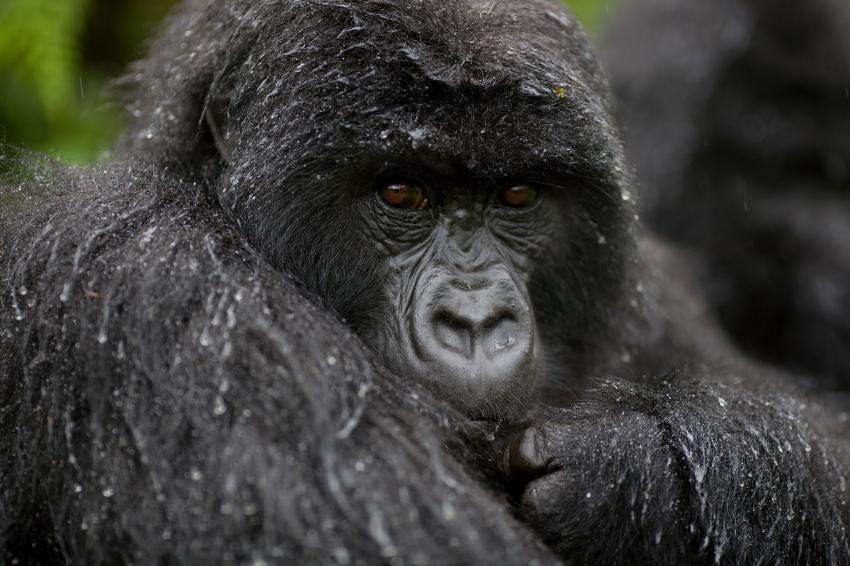Seeing the last remaining mountain gorillas of Africa in their natural habitat is a once-in-a-lifetime experience. Listening to their low, heavy grunts and watching their playful offspring is an encounter that will live long in your memory and is on many visitors “bucket lists”.

But before you plan your adventure, there’s one big question - to go mountain gorilla trekking in Uganda’s Bwindi Impenetrable National Park or Rwanda’s Volcanoes National Park?
Both countries are cooperating in their conservation efforts to preserve these magnificent creatures, with tight regulations when it comes to visitor numbers, duration of visits and the proximity you must maintain between you and the gorillas. Guides and scouts in both countries are highly trained and have an intimate understanding of the jungle environment and the mountain gorilla families.

But permit costs and accessibility between the two parks are wildly different, meaning there’s a few pros and cons to weigh up. So in this guide, we’ll explain the difference between the two destinations and some of the factors to take into consideration when making your decision to ensure you experience the best safari in Africa.
Permit costs and park accessibility
There’s currently a big difference in the cost of permits between the two countries, with a Rwanda gorilla tracking permit now costing $1500 and Uganda gorilla tracking permits $600. Both experiences allow you to spend one hour with a gorilla family observing them in the wild, accompanied by guides and scouts.

But Uganda has also introduced what’s known as a Gorilla Habituation Experience, which allows you to spend four hours with a gorilla family alongside researchers who assist gorillas in habituating to humans. You might have the opportunity to participate in making calls or analysing behaviors, as well as get insights from experts in the field. The Gorilla Habituation Experience in Uganda is currently $1,500.
But you might be asking, “is there any real difference in the experience you get between the standard Uganda and Rwanda gorilla permits?” For the experience itself, no as both will require you to trek to see the gorillas and this will vary depending on where the families are on the day of your experience.
There is, however, a difference in access, with Rwanda’s Volcanoes National Park only about 125kms (two hours’ drive) from the Kigali International Airport. If you’re travelling to Uganda’s Bwindi Impenetrable National Park, you’ll need around eight hours to drive from the Entebbe International Airport or take a domestic flight to Kihihi, which is around 40 kilometres from the entrance to the Bwindi Impenetrable National Park.
So the additional transport costs of getting the park may be a few hundred dollars extra, plus the costs of overnight accommodation. If you’re visiting the gorillas in Rwanda, it’s possible to do a trek in one day and fly home or do it as a two-day side trip following a Tanzania/Kenya safari.
If you’re not short on time, the long drive to Bwindi Impenetrable National Park is quite beautiful, taking you past the Lake Mburo National Park. It’s also possible to make a detour to the wildlife-rich Queen Elizabeth National Park, which will complement a Serengeti safari or visiting the Ngorongoro Crater on a Tanzania safari. The rural scenery along the way is spectacular and will allow you to see a lot more of Uganda than those who take the domestic flight.

That being said, there are sections of road that aren’t so comfortable to drive on the route between Entebbe and the Bwindi Impenetrable National Park. On the other hand, the short drive from Kigali to the head office of the Volcanoes National Park is on a sealed tarmac road (with a 4x4-only road to the gorilla trekking trailheads).
It’s important to keep in mind that June to September and December to January are the peak tourist seasons and permits are in high demand. You need to plan ahead if you want to visit during this period as securing a permit at short notice can be next to impossible. But that’s one of the benefits of booking through a tour operator as they will do the hard work for you in securing a permit for the day you want to trek.

Keep in mind that April to May and November are the low, rainy season and hiking conditions will be more difficult with muddy and slippery trails. However, with the reduced crowds, you may have the forests, mountains and gorillas all to yourself.
Trekking duration and gorilla sightings
In both countries, your chances of seeing the gorillas are almost guaranteed as the families are habituated and followed every day. Trackers will normally head out in the morning to check the location of the gorillas, then radio them into your guides so they know how far you will have to trek.
If you’re lucky, the gorillas may be feeding on the lower mountain slopes and less than an hour’s trek from the park entrance. But they might also be four or five hours away, which gives you a great opportunity to spot the rich birdlife along the way. That’s why it’s important that you’re in good health and trekking fitness, prepared for whatever conditions await. You need to carry enough water for what might be a 10-hour trekking day and take into consideration how your body responds to being at altitude, as you will be trekking at a slight elevation. If you know your body doesn’t respond well to physical activity at elevation, give yourself an additional day to adjust before you trek.

Once you reach the gorillas, you’ll be allowed one hour to spend with them (unless you’ve opted for the four-hour experience), with the opportunity to observe and photograph the family. There are strict regulations about how close you are allowed to get to the gorillas, so always listen and obey your guides’ instructions. The main difference between the two countries is that Uganda’s Bwindi Impenetrable National Forest features dense jungle thickets that can obscure clear views while Rwanda’s Volcanoes National Park has large stands of bamboo and open meadows that often allow for easier viewing.
Other in-country experiences
While Uganda and Rwanda have gained a reputation for their gorilla trekking, both countries offer other attractions and reasons to stay a little longer. If you want to combine a gorilla trek with a classic savannah safari, then Uganda is a good option as it’s home to the Queen Elizabeth National Park where you can get up close to leopards, hippos and Nile crocodiles. It’s also an adventure hub for white water rafting on the Blue Nile and bird watching in the breathtakingly beautiful Murchison Falls National Park.
Rwanda is no less picturesque, with rolling hills that are patch-worked with agricultural fields and home to the poignant Kigali Genocide Memorial. You can trek through the ancient montane rainforest of the Nyungwe National Park to witness chimpanzees in the wild or cycle along the legendary Congo Nile Trail as it hugs the sparkling waters of Lake Kivu.
Visa requirements
Finally, it’s important to remember that wherever you choose to visit, you will need to secure a visa before entering the country. Both Rwanda and Uganda issue visas on arrival for citizens of most countries, with Rwandan tourist visas currently $30USD and Ugandan tourist visas $50USD.
Want to add a gorilla trekking experience to your Tanzania safari package? Chat with our expert safari planners today!
Topics: Rwanda Gorilla Trekking in the “Land of a Thousand Hills”


 1-321-766-6821
1-321-766-6821 








